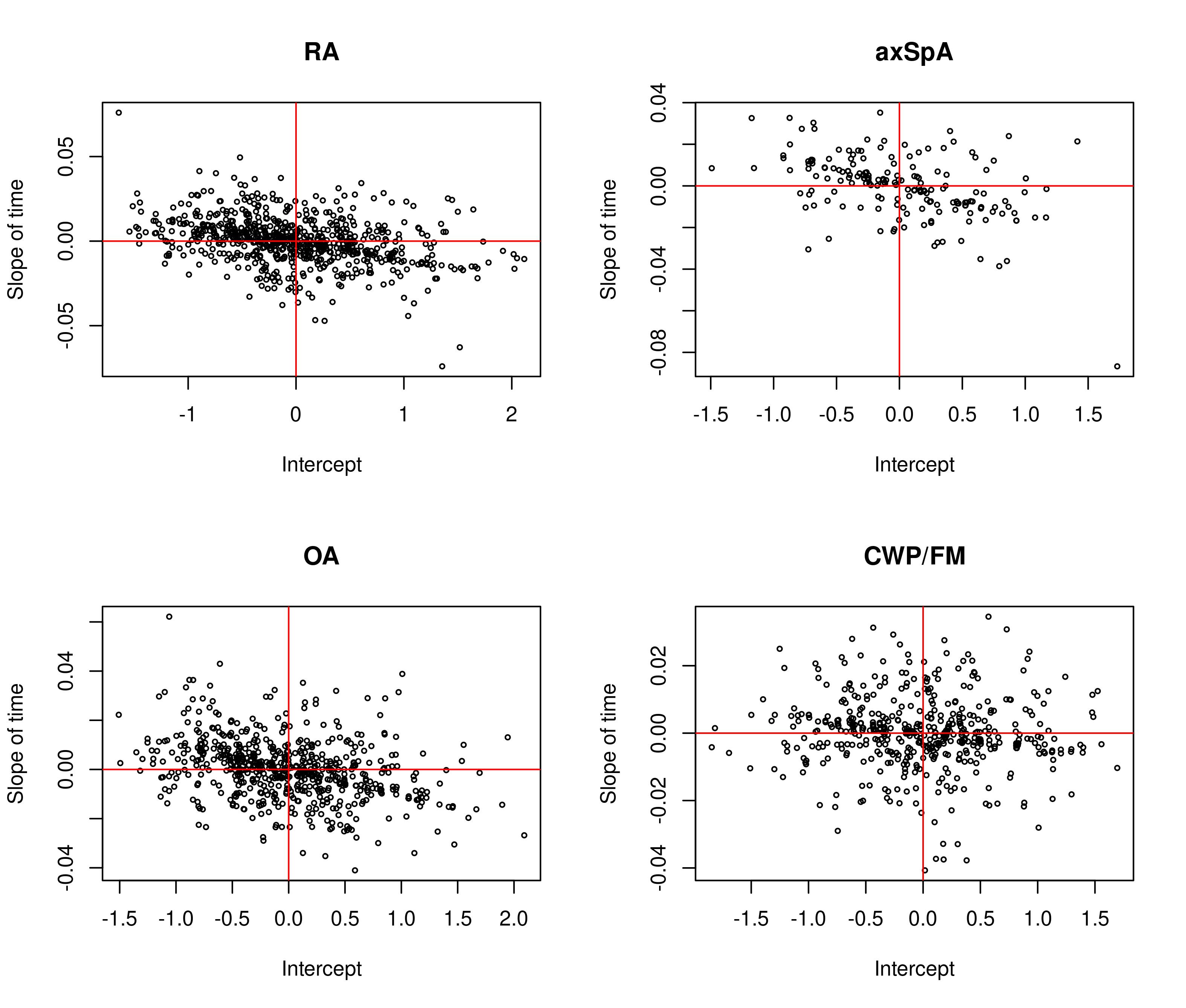Session Information
Date: Saturday, November 7, 2020
Title: Epidemiology & Public Health Poster II: OA, Osteoporosis, & Other Rheumatic Disease
Session Type: Poster Session B
Session Time: 9:00AM-11:00AM
Background/Purpose: Chronic pain is common in rheumatic and musculoskeletal diseases (RMDs), yet the patterns and the extent of variability over time are poorly understood. Real-time longitudinal capture of pain symptoms using smartphones enables the assessment of temporal patterns of pain, which are important indicators of disease activity. We examined the day-to-day pain variability in inflammatory and non-inflammatory RMDs using Cloudy With a Chance of Pain, a national U.K. smartphone study.
Methods: 10,584 study participants (aged ≥18 years; chronic pain for ≥3 months) entered their daily pain using a downloaded smartphone app (on a five-point ordinal scale of 1 – no pain/ 2 – mild pain/ 3 – moderate pain/ 4 – severe pain/ 5 – very severe pain). 2,525 participants diagnosed with single RMD (rheumatoid arthritis – RA, axial spondyloarthropathy – axSpA, osteoarthritis – OA, chronic widespread pain/fibromyalgia – CWP/FM) were included (median symptom entry days: 165 [IQR 82-284]). Long-term and short-term day-to-day pain variability for the first one-month period were analyzed using multilevel and Markov transition models respectively.
Results: From 29,705 daily pain scores (83% female; mean age 48 years; median symptom entry days: 24 [IQR 15-29]), the average pain scores for the first one-month period were higher in participants with axSpA and OA compared with participants with RA (2.74±0.98, 2.61±0.96, and 2.53±0.98 respectively), although participants with CWP/FM had the highest average pain score of 3.06±1.04. In addition, participants with CWP/FM had the highest overall pain level (71.1% reported moderate-very severe pain), followed by participants with axSpA, OA, and RA (57.8%, 52.0%, and 47.9% reported moderate-very severe pain respectively). The long-term change in pain was significantly different between participants, with steeper time-based improvements in pain for participants with higher initial pain scores across all diseases. The day-to-day pain state transitions were unchanged in 50% of days across diseases, although the event of any increase in pain state was noted in 25% of days (e.g., ≥2-point increase was noted in 4% of days). 53% of those with CWP/FM remained in the ‘very severe’ pain state with minimal variation.
Conclusion: Participants with CWP/FM had the highest overall pain level followed by participants with axSpA, OA, and RA. These daily pain scores allow the assessment of gradual day-to-day changes through time. Patterns of improvement in those with higher initial pain scores were seen across diseases, perhaps representing regression to the mean. The volatility of changing pain states was comparable across diseases, suggesting no difference in flares. Our future work in identifying patterns of day-to-day pain will focus on analyzing the magnitude of day-to-day change in pain and the constructs of pain volatility.
 Table 1. Baseline characteristics for 2,525 study participants stratified by rheumatic and musculoskeletal diseases
Table 1. Baseline characteristics for 2,525 study participants stratified by rheumatic and musculoskeletal diseases
 Figure 1. Slope-intercept plots for the multilevel model stratified by rheumatic and musculoskeletal diseases
Figure 1. Slope-intercept plots for the multilevel model stratified by rheumatic and musculoskeletal diseases
 Figure 2. Heat map plots for the Markov transition model stratified by rheumatic and musculoskeletal diseases
Figure 2. Heat map plots for the Markov transition model stratified by rheumatic and musculoskeletal diseases
To cite this abstract in AMA style:
Pisaniello H, Lunt M, McBeth J, Dixon W. Examining the Long-Term and Short-Term Day-To-Day Pain Variability in Inflammatory and Non-Inflammatory Rheumatic and Musculoskeletal Diseases Using Multilevel and Markov Transition Models: Cloudy with a Chance of Pain, a National U.K. Smartphone Study [abstract]. Arthritis Rheumatol. 2020; 72 (suppl 10). https://acrabstracts.org/abstract/examining-the-long-term-and-short-term-day-to-day-pain-variability-in-inflammatory-and-non-inflammatory-rheumatic-and-musculoskeletal-diseases-using-multilevel-and-markov-transition-models-cloudy-wit/. Accessed .« Back to ACR Convergence 2020
ACR Meeting Abstracts - https://acrabstracts.org/abstract/examining-the-long-term-and-short-term-day-to-day-pain-variability-in-inflammatory-and-non-inflammatory-rheumatic-and-musculoskeletal-diseases-using-multilevel-and-markov-transition-models-cloudy-wit/
